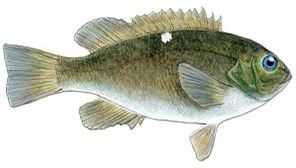Opaleye

Species Details
Girella Nigricans
Girellidae
Perciformes
Nearshore
1 - 4 lbs.
8" - 26"
About the Opaleye (Girella nigricans)
The Opaleye fish has large blue-green opalescent eyes, from where it gets its name from. They have cylindrical and dense bodies that are olive green or gray-green color, with two cream-colored spots at the end of the dorsal fin. They can also be light green and albinos have occasionally been reported. They are often confused with the Halfmoon, the Gulf Opaleye, and the Zebraperch.
Opaleyes may have a white line across their jaw or just below their eyes. They typically have a short snout with a small mouth and small incisiform teeth. Their anal fin has 3 spines with around 10 to 13 rays, and their dorsal fin has 12 to 13 spines. They have short, rounded pectoral and pelvic fins.
Diet and Size
These fish are primarily herbivorous, feeding on kelp, sea lettuce, seaweed, and algae, although it is common for them to consume any crustaceans or worms attached to aquatic plants. They may form populated schools over kelp beds.
Generally a small fish, most opaleyes are around 14 inches long but they have been reported to reach up to 25 inches in length. They mature and spawn at approximately 8 to 9 inches long. The all-tackle record as of 2019 is at a weight of 4 lbs and 0 oz.
Interesting facts about the Opaleye
- They transform into a monotonous dark brown color upon death
- They can breathe air or survive outside the water for hours as long as they remain wet
Habitat & Distribution
Opaleyes dwell in shallow reefs that have kelp beds, but may also be found in tide pools as juveniles. Adults favor rocky areas with an abundance of algae while juveniles stay near to the surface, gradually moving to deeper waters as they mature.
Opaleyes occupy the Eastern Central Pacific, normally off the coast of the San Francisco Bay in the United States, up to the edge of Baja California in Cabo San Lucas, Mexico. They have been occasionally found near the coast of Oregon.
They can withstand temperatures as low as 46 degrees Fahrenheit but can find a warmer 95 degrees tolerable. They are non-migratory and dwell at depths between 6 to 20 feet, but can go as deep as 100 feet.
These fish spawn from April to June, dispersing their eggs into the water column which can then travel for several miles. Although not typically a schooling fish, they will form dense schools during spawning and juveniles may form small groups in tide pools.
They are generally found in Mexican waters up to Southern California but have small localized populations in the Sea of Cortez.
Opaleye - Fishing Techniques
The opaleye is regarded as a difficult species to catch but a favorite gamefish of anglers, as they are wary of lines and can put up a fight when hooked. Small to mid-size opaleye can be caught off almost any pier in southern California that is near rocks, reefs, or kelp.
Recommended areas include Coast Guard Pier and Green Pleasure pier, as opaleyes can be found in schools consisting of 2 to 4-pound individuals. Typically, you should use an 8 to 10 fluorocarbon line, but if the fish seem hesitant, you can lighten it up to a 2 to 4 with small hooks of size 6 or less.
Another suggested area is Cabrillo Mole Pier, as the kelp near the railing are natural lures for the opaleyes. When fishing here, you should not allow the fish to swim into the dense vegetation of the kelp blades, as it will decrease your chances of hooking them.
Opaleyes are generally around five to ten feet beneath the surface and you can use a long slip float or slip bobber to monitor your depth. Once caught, steadily apply pressure as you pull them towards you. You may need help to net them as these fish can be quite strong. If using a lighter line, balance the pressure correspondingly with your line’s weight.
Older opaleyes are the most difficult to catch, and chumming with frozen peas or moss is highly recommended. You can throw a handful of frozen peas to attract a school, or hook a single pea. The peas must be frozen so they can’t nibble at it and take it as a whole. Fresh mussels, bloodworms, and rock crabs work nicely as well, as long as you keep your hook at a relatively small size.







